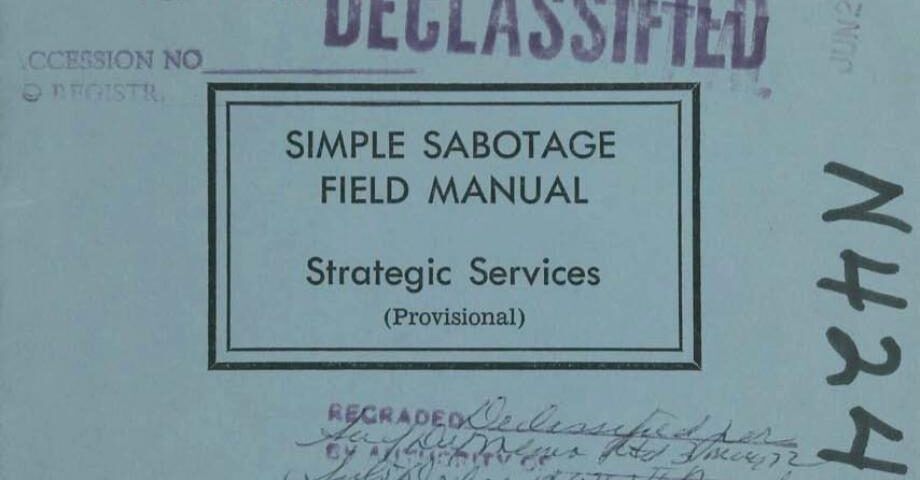
Unlocking Synergistic Performance: Harnessing Personalities and Strengths for Optimal Team Dynamics
May 4, 2024
From Resistance to Acceptance: A Roadmap for Organizational Change
July 2, 2024Is Your Company Being Sabotaged by Inefficiency? Here’s How to Fix It

One of the most intriguing documents I’ve come across recently is the Simple Sabotage Field Manual, a World War II-era guide created by the Office of Strategic Services (OSS), the predecessor to the CIA. Developed in 1944 and declassified in 1963, the manual provided practical guidelines for ordinary citizens in occupied territories to disrupt enemy operations. Many of these tactics were effectively employed by the French Resistance to undermine Nazi efforts.
The final section on “General Interference with Organizations and Production” is particularly fascinating from a modern business perspective because it highlights management behaviors and practices that, though intended for sabotage, parallel many organizational inefficiencies seen in companies today.
Sabotage Techniques that Mirror Modern Organizational Inefficiencies
Here are some of the manual’s recommendations for managers that may sound eerily familiar:
- Insist on doing everything through “channels” to slow down decisions
- Refer all matters to large committees for “further study and consideration”
- Bring up irrelevant issues as frequently as possible
- Haggle over precise wordings of communications
- Re-open decisions that were made at previous meetings
- Ask endless questions or engage in long correspondence about tasks
- Insist on perfect work in relatively unimportant products
- To lower morale and production, favor inefficient workers over efficient ones
- Contrive as many interruptions to work as you can
- Hold meetings when there is more critical work to be done
- Do your work poorly and blame it on someone or something else
- Be as irritable and quarrelsome as possible
If any of these examples describe the behavior of one or more managers in your organization, it’s a red flag. While they may not intend harm, their leadership style can still have a sabotaging effect on your team’s productivity. Worse, the bureaucracy they create can insidiously infiltrate your company culture.
What Can You Do About It?
To counteract these inefficiencies, it’s essential to set a positive example of effective leadership. Here are five recommendations to help maximize your team’s efficiency and effectiveness:
1. Be Decisive
- Make Timely Decisions: Understand that a good decision today is better than a perfect decision made too late. Given today’s high-velocity operating environment, speed matters, and “too late” is sooner than it used to be (this reminds me of Yogi Berra’s famous quote, “It gets late early out there” when shadows made it tough to see the ball off the bat during afternoon games in Yankee Stadium).
- Get Comfortable with Uncertainty: Learn to be comfortable making “good” decisions with imperfect information. Avoid paralysis through analysis and be okay with the 80% solution when appropriate.
- Stick to Decisions: Don’t revisit decisions unless the underlying assumptions have changed.
2. Decentralize Execution
- Be Clear: Establish a clear vision and set clear expectations for your team.
- Empower Your Team: Delegate and empower your team to execute. Push decision-making authority to the lowest practical level, trusting them to get the job done.
- Communicate Effectively: Create a communication strategy and cadence to ensure shared awareness among decision-makers without over-relying on meetings. Ensure every meeting has a clear purpose, objectives, and agenda. Carefully consider who needs to attend to minimize organizational meeting fatigue. Send a meeting summary to those who don’t need to attend but need to be informed. AI applications can help you summarize meetings.
3. Ruthlessly Prioritize
- Focus on Key Priorities: When everything is a priority, nothing is a priority. Help your team keep the main things the main things.
- Align Regularly: Discuss priorities weekly with direct reports to ensure alignment.
4. Reward High-Performers
- Recognize Contributions: Find and acknowledge the contributions of your team members that directly impact mission success. A simple thank you can go a long way, especially when given in front of peers. Consider awards and letters of appreciation as well.
- Provide Tangible Rewards: Bonuses and promotions can significantly boost incentive, morale, and productivity.
5. Be Accountable
- Own Your Leadership: Take ownership of your leadership and performance. Hold yourself accountable for your team’s performance as well.
- Foster Continuous Improvement: Don’t expect perfect work from imperfect people. Train, develop, and coach your team to continuously improve and learn from their mistakes.
- Create Trust: Lead with character, competence, and composure so that your team members will trust your intentions, actions, and emotions.
Next Steps
Measure your team’s progress and document your accomplishments. Sharing your lessons learned with colleagues who might be unknowingly sabotaging their teams can help influence them to become more aware and change their style.
If your boss or other senior leadership in your organization are the ones sabotaging your culture, your challenge is more difficult. Consider ways to leverage your lessons learned to “influence up” and help create a more efficient and effective culture.
Conclusion
By recognizing and addressing inefficiencies that resemble sabotage tactics, you can transform your organization’s productivity and culture. Lead by example, empower your team, and maintain accountability to drive success. With these strategies, you can overcome the subtle sabotages of inefficiency and build a more dynamic and effective organization.
If you need assistance implementing any of these strategies, we’re here to help.
